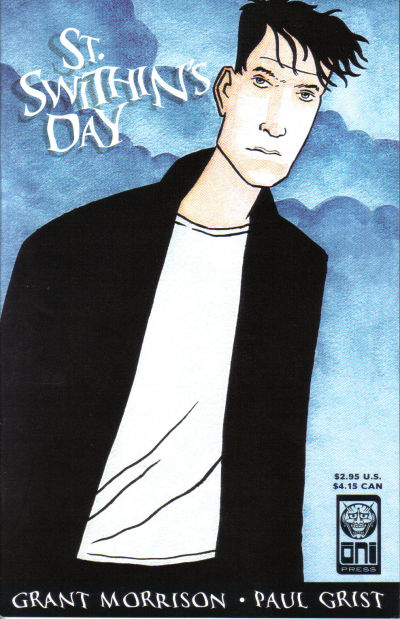Of all of Grant Morrison’s stories, not even The New Adventures of Hitler got them in as much problems as this. Parliamentary questions were asked. All because it’s a comic about killing Margaret Thatcher…

In 1989 Grant Morrison had just begun their conquest of American comics, having started writing Animal Man the year before and having just taken over Doom Patrol from Paul Kupperberg, both on the strength of their work in the UK, notably Zenith. At the time they were also still writing for UK publishers, with the aforementioned The New Adventures of Hitler in pop culture magazine Cut and with St Swithin’s Day serialised in the anthology comic Trident, from Trident Comics. A story in four parts with art by Paul Grist, it would be released by Trident in a collected edition in 1990 and seven years later by Oni Press for the American market. The last one is the edition I have. St Swithin’s Day is the story of a nameless nineteen year old teenager plotting to assassinate Margaret Thatcher with a gun he found after a bank robbery. The story follows him a few days before she’s due to visit a school on July 15 (Saint Swithin’s Day). He steals Catcher in the Rye from Foyles bookshop to because “he wants them to find it” in his pocket afterwards. He also gets the collected works of Rimbaud for the same reason. It’s the sort of pretentious facade an intellectual nineteen year old would come up with. A little later he talks about how he doesn’t want to go back to his old room at his mother’s, with the Tolkien posters on the wall from when he was fifteen. Morrison has said that St Swithin’s Day partially autobiographical and based on these things I can see it.
Our protagonist then spends the day in Winchester, holed up in a cafe ogling a lone girl before having a conversation with an imaginary friend (also a girl). Depressed when the real girl’s date shows up, he leaves and spent the night sleeping in a work cabin, then the next day drops all his stolen book and stolen Walkman in a canal, deciding not to give “them” the pleasure of analysing him. The night before his assassination attempt, he breaks into Highgate Cemetary and dances in front of Karl Marx’s grave, to the tune of The La’s “there She Goes”, which is very, very of its time for when this was originally published.
As Thatcher visits the school, he manages to get close to her, gets her attention and shoots, but with an imaginary finger gun. Struck down and beaten up by the cops protecting her, the last page is of him on an old fashioned train with windows that can open, in the summer.
Now obviously this isn’t really a story about wanting to murder Thatcher, even if quite a few people would’ve wanted to kill her at the time. (In one of his imaginations of what would happen if he did kill her, the protagonist imagines street parties, which is indeed what did happen in certain places when she did pop her clogs much too late…) It’s rather a psychological portray of a sensitive teenager wanker, whose father had died sometime before the story opens, running away from becoming an adult, his mother pressing him to take a job. Nevertheless, The Sun got hold of it, whipped up a small moral panic, some Tory asked questions in parliament and Trident used all this as free advertising… So it goes.
No Comments